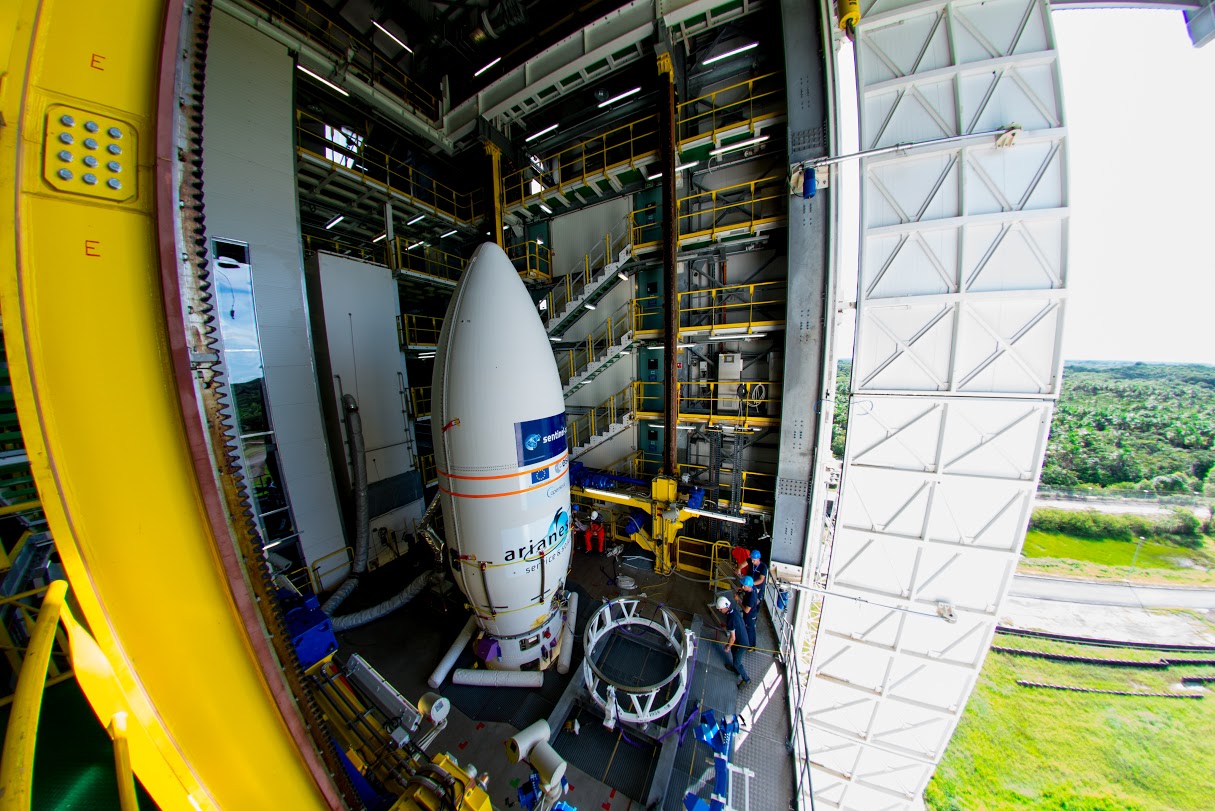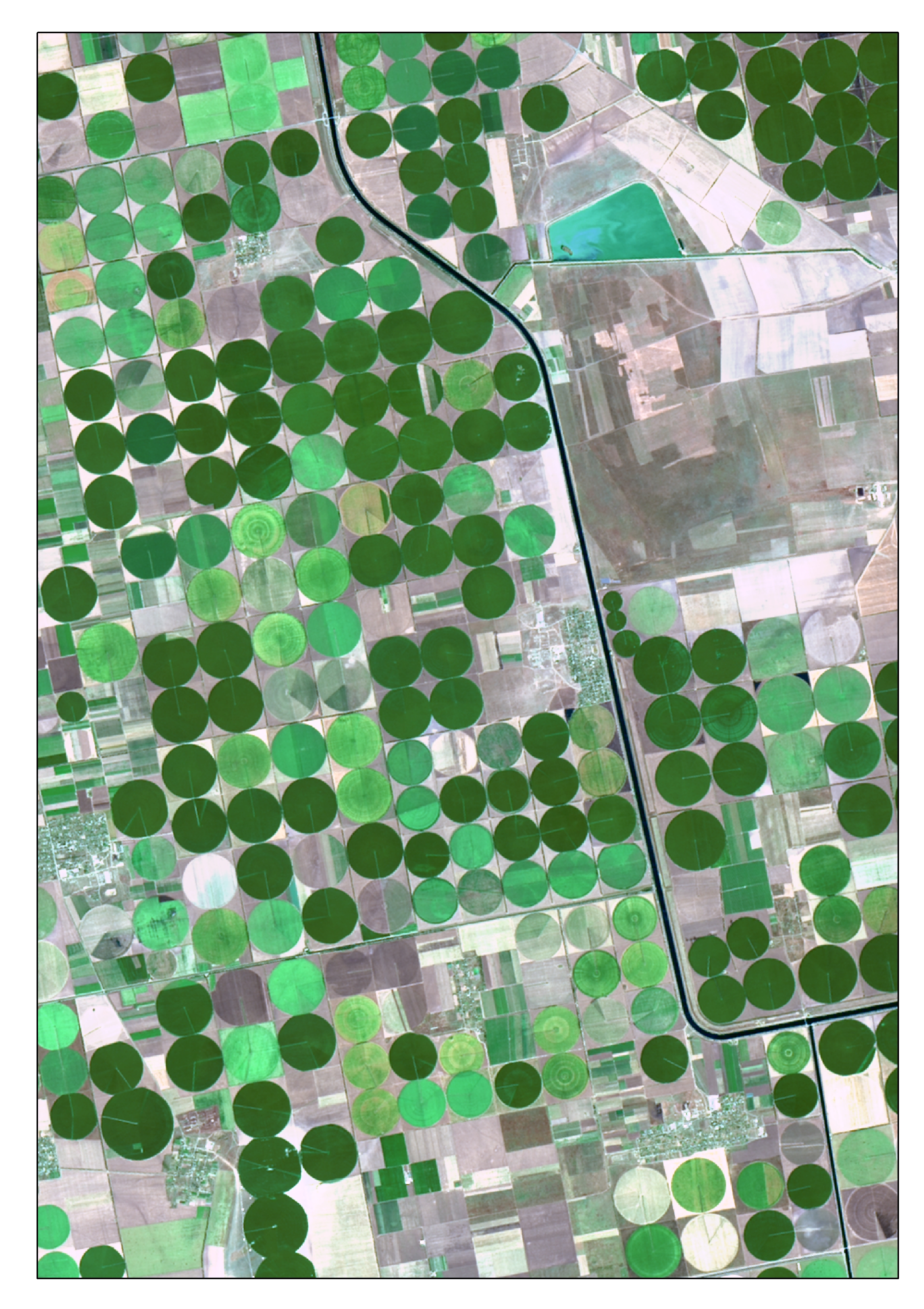|
Sentinel-2
Sentinel-2 is an Earth observation mission from the Copernicus Programme that acquires optical imagery at high spatial resolution (10 m to 60 m) over land and coastal waters. The mission's Sentinel-2A and Sentinel-2B satellites were joined in orbit in 2024 by a third, Sentinel-2C, and in the future by Sentinel-2D, eventually replacing the A and B satellites, respectively. The mission supports services and applications such as agricultural monitoring, emergencies management, land cover classification, and water quality. Sentinel-2 has been developed and is being operated by the European Space Agency. The satellites were manufactured by a consortium led by Airbus Defence and Space in Friedrichshafen, Germany. Overview The Sentinel-2 mission includes: * Multispectral image, Multi-spectral data with 13 bands in the Visible spectrum, visible, Infrared#Regions within the infrared, near infrared, and Infrared#Regions within the infrared, short wave infrared part of the Electromagnetic ... [...More Info...] [...Related Items...] OR: [Wikipedia] [Google] [Baidu] [Amazon] |
Sentinel-2A
Sentinel-2A is a European optical imaging satellite launched in 2015. It is the first Sentinel-2 satellite launched as part of the European Space Agency's Copernicus Programme. The satellite carries a wide swath high-resolution multispectral imager with 13 spectral bands. Its observations support services such as forest monitoring, land cover change-detection, natural disaster management and water quality monitoring. On 7 March 2017 the Sentinel-2A was joined in orbit by its sister satellite, Sentinel-2B. Mission history Launch Sentinel 2A was launched by the Vega (rocket), Vega Vega flight VV05, VV05 rocket on 23 June 2015 at 01:52 UTC. The satellite separated from the upper stage 54 min 43 s after liftoff. Orbital operation The satellite captured its first image 100 hours after launch, covering a wide swath from Sweden through Central Europe to Algeria. Commissioning occurred in October 2015. Between 20 and 23 January 2017 the spacecraft suffered a mission planning ano ... [...More Info...] [...Related Items...] OR: [Wikipedia] [Google] [Baidu] [Amazon] |
Sentinel-2B
Sentinel-2B is a European optical imaging satellite that was launched on 7 March 2017. It is the second Sentinel-2 satellite launched as part of the European Space Agency's Copernicus Programme, and with its orbit phased 180° against its sister satellite, Sentinel-2A. The satellite carries a wide swath high-resolution multispectral imager with 13 spectral bands. It provides information for agriculture and forestry, among other services, allowing for prediction of crop yields. Mission history A €105 million contract for the construction of the spacecraft was signed in March 2010 by ESA's Director of Earth Observation Programmes and the CEO of Astrium, Astrium Satellites. It was completed in June 2016, and the satellite was transported to the European Space Research and Technology Centre (ESTEC) for the test campaign. Launch The spacecraft arrived at the Guiana Space Centre, Centre Spatial Guyanais on 6 January 2017 for pre-launch operations. Launch took place at the nomi ... [...More Info...] [...Related Items...] OR: [Wikipedia] [Google] [Baidu] [Amazon] |
Copernicus Programme
Copernicus is the Earth observation component of the European Union Space Programme, managed by the European Commission and implemented in partnership with the Member state of the European Union, EU member states, the European Space Agency (ESA), the European Organisation for the Exploitation of Meteorological Satellites (EUMETSAT), the European Centre for Medium-Range Weather Forecasts (ECMWF), the Joint Research Centre (JRC), the European Environment Agency (EEA), the European Maritime Safety Agency (EMSA), Frontex, European Union Satellite Centre, SatCen and Mercator Océan. The programme aims at achieving a global, continuous, autonomous, high quality, wide range Earth observation capacity. Providing accurate, timely and easily accessible information to, among other things, improve the management of the environment, understand and Climate change mitigation, mitigate the effects of climate change, and ensure civil security. Since 2021, Copernicus is a component of the Europ ... [...More Info...] [...Related Items...] OR: [Wikipedia] [Google] [Baidu] [Amazon] |
Vega (rocket)
Vega (, , ) was a European expendable small-lift launch vehicle developed by Avio and operated by Arianespace for the European Space Agency (ESA) and the Italian Space Agency (ASI). Designed to carry payloads between into low Earth and polar orbits, Vega served primarily scientific and Earth observation missions. Development of Vega began in 1998, with its maiden flight launched from the Guiana Space Centre on 13February 2012. Over the next decade, it became the eighth most launched small-lift launch vehicle history, though it struggled to compete in the commercial launch market. After initial success, two in-flight failures and rising competition from SpaceX's rideshare programs, which offered lower prices, relegated Vega to primarily serving European government agencies willing to pay more to support independent space access. The rocket took its name from Vega, the brightest star in the constellation Lyra. It featured a single-body design without strap-on boosters, con ... [...More Info...] [...Related Items...] OR: [Wikipedia] [Google] [Baidu] [Amazon] |
SPOT (satellite)
SPOT (, lit. "Satellite for observation of Earth") is a commercial high-resolution optical Earth observation satellite system operating from space. It is run by Spot Image, based in Toulouse, France. It was initiated by the CNES (''Centre national d'études spatiales'' – the French space agency) in the 1970s and was developed in association with the SSTC (Belgian scientific, technical and cultural services) and the Swedish National Space Board (SNSB). It has been designed to improve the knowledge and management of the Earth by exploring the Earth's resources, detecting and forecasting phenomena involving climatology and oceanography, and monitoring human activities and natural phenomena. The SPOT system includes a series of satellites and ground control resources for satellite control and programming, image production, and distribution. Earlier satellites were launched using the European Space Agency's Ariane 2, 3, and 4 rockets, while SPOT 6 and SPOT 7 were launched by ... [...More Info...] [...Related Items...] OR: [Wikipedia] [Google] [Baidu] [Amazon] |
Spot 5
SPOT (, lit. "Satellite for observation of Earth") is a commercial high-resolution optical Earth observation satellite system operating from space. It is run by Spot Image, based in Toulouse, France. It was initiated by the CNES (''Centre national d'études spatiales'' – the French space agency) in the 1970s and was developed in association with the SSTC (Belgian scientific, technical and cultural services) and the Swedish National Space Board (SNSB). It has been designed to improve the knowledge and management of the Earth by exploring the Earth's resources, detecting and forecasting phenomena involving climatology and oceanography, and monitoring human activities and natural phenomena. The SPOT system includes a series of satellites and ground control resources for satellite control and programming, image production, and distribution. Earlier satellites were launched using the European Space Agency's Ariane 2, 3, and 4 rockets, while SPOT 6 and SPOT 7 were launche ... [...More Info...] [...Related Items...] OR: [Wikipedia] [Google] [Baidu] [Amazon] |
European Space Agency
The European Space Agency (ESA) is a 23-member International organization, international organization devoted to space exploration. With its headquarters in Paris and a staff of around 2,547 people globally as of 2023, ESA was founded in 1975 in the context of European integration. Its 2025 annual budget was €7.7 billion. The ESA Human and Robotic Exploration programme includes human spaceflight (mainly through participation in the International Space Station programme); as well as the launch and operation of missions to Mars and Moon. Further activities include science missions to Jupiter, Mercury, the Sun, Earth observation, Asteroid impact avoidance and Telecommunications missions, designing launch vehicles; and maintaining Europe's Spaceport, the Guiana Space Centre at Kourou (French Guiana). Further programmes include space safety, satellite navigation, applications and commercialisation. The main European launch vehicle Ariane 6 is operated through Arianespace ... [...More Info...] [...Related Items...] OR: [Wikipedia] [Google] [Baidu] [Amazon] |
Sentinel-1
Sentinel-1 is the first of the Copernicus Programme satellite constellations conducted by the European Space Agency. The mission was originally composed of a constellation of two satellites, Sentinel-1A and Sentinel-1B, which shared the same orbital plane. Sentinel-1B was retired following a power supply issue on December 23, 2021, leaving Sentinel-1A the only satellite of the constellation currently operating. Sentinel-1C has been successfully launched on 5 December 2024, 21:20 UTC, and is still ongoing in-orbit commissioning before becoming fully operational. Sentinel-1D is in development and its launch is planned for 2025. Overview The first satellite, Sentinel-1A, launched on 3 April 2014, and Sentinel-1B was launched on 25 April 2016. Both satellites lifted off from the Guiana Space Centre in Kourou, French Guiana on a Soyuz (rocket), Soyuz rocket. Sentinel-1D is in development. An equipment failure on Sentinel-1B in December 2021 accelerated work on Sentinel-1C, which has ... [...More Info...] [...Related Items...] OR: [Wikipedia] [Google] [Baidu] [Amazon] |
Sentinel-3
Sentinel-3 is an Earth observation heavy satellite series developed by the European Space Agency as part of the Copernicus Programme. As of 2024, it consists of 2 satellites: Sentinel-3A and Sentinel-3B. After initial commissioning, each satellite was handed over to EUMETSAT for the routine operations phase of the mission. Two recurrent satellites, Sentinel-3C and Sentinel-3D, will follow in approximately 2025 and 2028 respectively to ensure continuity of the Sentinel-3 mission. Each Sentinel-3 satellite is designed to operate for seven years in a sun-synchronous low-Earth orbit. The satellites use multiple sensors to measure topography, temperature, marine ecosystems, water quality, pollution, and other features for ocean forecasting and environmental monitoring. Overview The Sentinel-3 satellites travel in a sun-synchronous orbit at an altitude of approximately , with an inclination of 98.6° and orbit cycle of approximately 100 minutes. The local time of descending nod ... [...More Info...] [...Related Items...] OR: [Wikipedia] [Google] [Baidu] [Amazon] |
Landsat
The Landsat program is the longest-running enterprise for acquisition of satellite imagery of Earth. It is a joint NASA / USGS program. On 23 July 1972, the Earth Resources Technology Satellite was launched. This was eventually renamed to Landsat 1 in 1975. The most recent, Landsat 9, was launched on 27 September 2021. The instruments on the Landsat satellites have acquired millions of images. The images, archived in the United States and at Landsat receiving stations around the world, are a unique resource for global change research and applications in agriculture, cartography, geology, forestry, regional planning, surveillance and education, and can be viewed through the U.S. Geological Survey (USGS) "EarthExplorer" website. Landsat 7 data has eight spectral bands with spatial resolutions ranging from ; the temporal resolution is 16 days. Landsat images are usually divided into scenes for easy downloading. Each Landsat scene is about 115 miles long and 115 miles wide ( ... [...More Info...] [...Related Items...] OR: [Wikipedia] [Google] [Baidu] [Amazon] |
Landsat 8
Landsat 8 is an American Earth observation satellite launched on 11 February 2013. It is the eighth satellite in the Landsat program and the seventh to reach orbit successfully. Originally called the Landsat Data Continuity Mission (LDCM), it is a collaboration between NASA and the United States Geological Survey (USGS). NASA Goddard Space Flight Center in Greenbelt, Maryland, provided development, mission systems engineering, and acquisition of the launch vehicle while the USGS provided for development of the ground systems and will conduct on-going mission operations. It comprises the camera of the Operational Land Imager (OLI) and the Thermal Infrared Sensor (TIRS), which can be used to study Earth surface temperature and is used to study global warming. The satellite was built by Orbital Sciences Corporation, who served as General contractor, prime contractor for the mission. The spacecraft's instruments were constructed by Ball Aerospace & Technologies and NASA's Goddard Sp ... [...More Info...] [...Related Items...] OR: [Wikipedia] [Google] [Baidu] [Amazon] |






